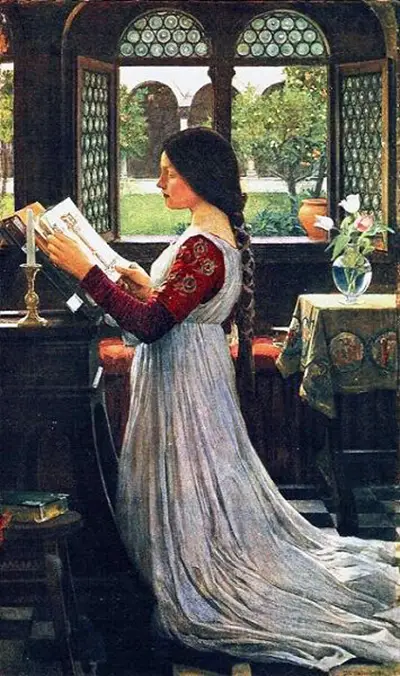Introduction to the Artist
Many of these types of scenes by Waterhouse would feature a small window at the back which allowed light into the composition. There would also be interesting details added around the room for further interest, and on some occasions these would hold symbolic value too.
Waterhouse was inspired by his studies of French and Italian art, but there are also indications of the influence of Dutch art too, such as in the manner of his domestic scenes. British Victorian artists took in a variety of ideas in this manner, and together forged their own new approach, with Waterhouse sitting on the fringes of the much-loved Pre-Raphaelite movement.
Description
In The Missal, the artist chose to open up the windows more so than in other paintings and this allows more light to flood in, as well as enabling us to appreciate the garden outside, which includes a fruit tree.
It is a tranquil setting from which this young woman reads, possibly from the Bible. There is also some stained glass detail to the windows and the framed doors are left fully opened.
Within the room is a small table with flowers in a vase perched on top. There is also a wider sitting chair up against the wall. The left hand side of the painting is darker, but we can make out a pretty candle besides the reader.The floor makes use of a black and white tiled design that Waterhouse chose to use in many of his domestic scenes, including Mariana in the South.
The model kneels to the left of the scene and he dress sweeps elegantly. Her outfit is pretty but without being too formal, which would be out of sync with the setting that we find in this painting. Waterhouse liked to add patterned designs to table cloths and he does so here - he continued this with some floor designs, but more so for his classical work that appeared earlier in his career.
Exhibited in 1902
John William Waterhouse chose to exhibit this painting alongside The Crystal Ball in the Royal Academy of 1902. The consistent style and output of this artist meant that he would normally be fairly confident of having his work accepted by the Academy as well as drawing interest from potential buyers.
Pre-Raphaelite Movement
The Pre-Raphaelite movement, of which he worked on the fringes, has endured fluctuating interest over the past century but at the moment is very much in-vogue. The way in which these artists concentrated on women and portrayed them as objects of desire and purity still appeals to some, and offers a refreshing return to old times against the more complex forms of modern art.
In a similar manner to the academic artists in both the UK and France, Waterhouse's approach would drift out of fashion for a number of years, due to the rise of abstract and expressionist art. Over time, however, a yearning for more traditional content would return and today Waterhouse is highly regarded within the realms of British art history.
Large Image of The Missal
A larger image of the original piece, below, offers up more detail. The artist went to great lengths within this scene to produce a realistic environment, with every corner of the canvas carefully considered and delivered. The touches given to the garden outside, as well as various items of furniture inside, are both entirely charming.


